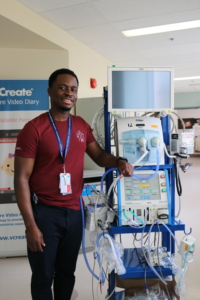Helping premature babies breathe is a critical role of St. Boniface Hospital’s Neonatal Intensive Care Unit (NICU).
To do that, respiratory therapists rely on specialized machines called high-frequency jet ventilators, used only in the NICU to support St. B’s tiniest and most vulnerable patients.
St. Boniface Hospital currently has two such jet ventilators on site. They have not always been enough, said Kwabena Osei-Bonsu, the Manager of Health Services for Respiratory Therapy and Perfusion at the Hospital.
“This would mean faster, safer care for babies in our NICU.”
“At times we have had to borrow more jet ventilators as needed from Health Sciences Centre Winnipeg Children’s Hospital,” said Osei-Bonsu. He explained St. B is working to double its count by adding two more jet ventilators this winter, with help from Foundation donors.
“Children’s Hospital has lent them to us; we ship them back, across the river back and forth. Our teams on each side have always found a way to make it work; we look out for each other,” he added. “But with two more jet ventilators here at St. B, we will not have to wait for a machine to cross the river. This would mean faster, safer care for babies in our NICU.”
Preemies’ care needs unique

Some babies at St. B who were born prematurely have underdeveloped lungs that need to be protected, explained Osei-Bonsu. The jet ventilators deliver small breaths very quickly, which is gentler and provides that needed protection. (Other premature babies in the NICU can breathe on their own and do not need a jet ventilator, he noted.)
“These jet ventilators were invented specifically for premature babies in the NICU. They are only made by one manufacturer in the world,” said Osei-Bonsu.
“How you and I breathe as adults, we move air in and out. When we take in oxygen, it goes into our lungs. When someone in the Hospital is on a ventilator, the machine pushes in air and the lungs will push back against that. Eventually they push out carbon dioxide. Repeatedly pushing air in and carbon dioxide out can cause damage because we are forcing the lungs open.”
“Whatever we do with babies in the NICU needs to be as protective as possible,” he said of St. B’s tiniest and most vulnerable patients. “If you repeatedly and forcefully push air in, you can cause long-lasting damage.”
“What the jet ventilator does is, rather than push air in, it moves a small volume of air really fast so there isn’t as much impact on the baby’s lung tissue going in,” he continued.
“It delivers a small volume of breath at such a rapid pace; it can move through the airways and still allow for carbon dioxide to come out in a gentler way while it’s doing that. We call that passive exhalation.”
Challenges take emotional toll
Donors offering help to add two more jet ventilators at St. Boniface Hospital will have an impact that goes even beyond just patients, said Osei-Bonsu.
“The obvious impact is to be able to support patient care. But often when we talk about impact we forget about staff. What it means for them when we are not able to deliver the care we want to, because we don’t have the resources on hand,” he said.
“Our department is full of dedicated respiratory therapists who got into health care to help people. For them to be able to help, you need to provide them with adequate resources to do their work. Often the barrier to that is funding.”
“Adding more jet ventilators will not only give us the capacity to be able to support babies who need it when they need it, but also for staff to not have to say, ‘We have to wait for another one to be delivered.’ Or worse, ‘We may have to take one from another patient.’ That all takes an emotional toll on staff.”


